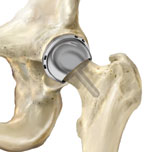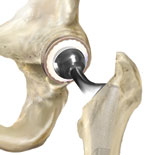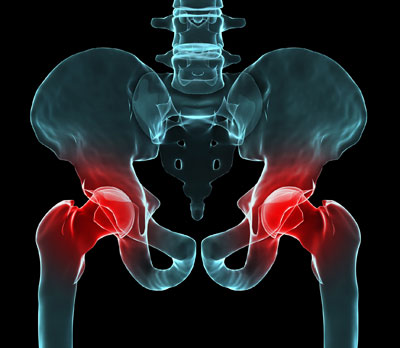Arthritis ain’t for sissies. As cartilage wears thin over the years, and bone begins to grind against bone, the ache of an arthritic joint can blossom into debilitating agony, hindering not only movement but, in the worst cases, sleep as well. This is especially true when the offending joint happens to be of the load-bearing variety, like the one in the hip. Orthopedic surgeons have long advised patients at such extremes of discomfort to get a total hip replacement and swap their offending joints for prostheses.
Today, they also offer an alternative procedure: the hip resurfacing surgery. The main advantage of the procedure, practiced for years abroad and approved by the FDA in 2006, is that it involves virtually no loss of bone. This means that when the resurfacing prosthesis wears out, patients are eligible for a total hip replacement that can last an additional 15 to 20 years. On the other hand, not everyone is eligible for resurfacing.
“In general,” says Dr. Craig Della Valle, a specialist in joint reconstruction at Rush University Medical Center in Chicago, “the best candidates for the procedure are young, active men, which is great. Those are the same patients who are at highest risk for failure with a conventional hip replacement. It’s nice when things work out that way.”
In total hip replacement, the orthopedic surgeon lops off the bulbous head and angled neck of the femur and puts in its place a ball-like prosthesis that is secured by a spike inserted deep into the lower portion of the bone. Resurfacing, meanwhile, spares bone because it leaves the head and neck of the femur intact. The surgeon instead reshapes the head of the femur to fit a toadstool-shaped prosthesis — a metal cap that is snapped onto the femoral head and held in place via a relatively short stem that slips into the femoral neck. The surgeon then inserts a metal cup into the socket as well. No one is sure yet how long these prostheses last on average.
Time isn’t the only thing resurfacing buys. Proponents say that people with resurfaced joints are capable of more vigorous activity than those who get total joint replacements. They are also more likely to recover their natural gait and enjoy a greater range of motion with the resurfaced joint. But the conservation of bone is probably the greatest advantage offered by the newer procedure. Dr. William Macaulay, a professor of orthopedic surgery at Columbia University Medical Center who trains other surgeons in resurfacing, notes that the relatively short length of the pin used to secure the femoral cap also preserves marrow, which is the source of all blood cells, and is particularly abundant in the femur.
 |
Hip Resurfacing: Surgeons reshape the head of the femur (large thigh bone) where it connects to the hip socket, then place a metal cap on the femoral head, which is held in place by a short stem drilled into the femur. |
 |
Total Hip Replacement: Damaged cartilage and bone, including the head and neck of the femur, are removed and replaced with a prosthetic ball and metal stem inserted into the femur bone and an artificial hip socket. |
| Images: © Edwards Lifesciences | |
Like any other procedure, resurfacing comes with its risks. For the most part, they’re identical to those that accompany total replacement. But there’s one major risk unique to resurfacing: the fracture of the femoral neck, a complication only remedied by a second surgery to perform a total hip replacement. To find out just how frequently this and other complications occur, Dr. Della Valle led a study of the outcomes of the first 537 hip resurfacing procedures performed in the United States since the resurfacing prosthetic devices won FDA approval. “This is something new, and it’s a pretty difficult procedure,” says Dr. Della Valle. “We wanted to make sure that the complication rate in adopting this technology wasn’t horrendous.”
The 89 orthopedic surgeons who conducted the procedures had varying degrees of experience in hip surgeries. Further, they had done resurfacings on average just six times. “These guys were your average orthopedic surgeons who were trying a new procedure,” says Dr. Della Valle. He and his colleagues reported in the December issue of Clinical Orthopaedics and Related Research that of the 32 serious complications they tallied, 10 were fractures of the femoral neck.
The details are revealing. Nine of those 10 fractures were in patients who were either female or were 55 or older when they received the implant. That underscores the importance of patient selection to the success of resurfacing: The ideal candidate needs to have relatively dense and strong bones to reduce the risk of femoral neck fractures. This requirement eliminates most postmenopausal women, and men over the age of 55 as candidates for the procedure.
Dr. Della Valle’s results confirm the findings of a study published in PLoS Medicine earlier this year of 76,576 replacement and resurfacing surgeries conducted in the U.K. between 2003 and 2006. The researchers found that 1.4 percent of the patients had to have surgeries within three years to repair failed hip procedures of both types. But the overall revision rate for resurfacing was almost twice as high, at 2.6 percent. Among women, it was even higher, at 3.7 percent, as opposed to just 1.9 percent of men.
Surgeons, however, stress that patients need to be assessed on a case-by-case basis — some women may in fact be perfect for resurfacing. Still, even experienced orthopedists can only be sure about any particular patient after inspecting the femoral head and socket directly. On the plus side, making that decision in midsurgery adds neither expense nor risk to the procedure, says Dr. Macaulay. The two surgeries, he says, can be started in essentially the same way.
The resurfacing procedure is, however, more technically demanding than total joint replacement. Retaining the neck and head of the femur, for instance, makes it much harder for the surgeon to expose the socket. Shaping the femoral head appropriately also takes practice — and if the surgeon does that poorly, the patient is far more likely to suffer a femoral neck fracture. Indeed, Dr. Della Valle and his colleagues found that eight of the 10 femoral neck fractures they counted were in patients whose surgeons had done fewer than 10 resurfacing surgeries.
So what should you look for in a surgeon if you’re shopping for a hip resurfacing?
Expertise matters, of course — and the more resurfacing procedures your surgeon has done the better. “I think the learning curve is somewhere around 50 cases,” says Dr. Macaulay. When you find one with at least that much experience, he says, it’s wise to ask to speak to some of the surgeon’s former patients. Finally, make sure that the surgeon is the sort who’s likely to pay attention to you both before and after the procedure. This is, after all, a major surgery.
“If they don’t have much time for you before the surgery, they’re going to have even less time for you after,” says Dr. Macaulay. “I would choose my surgeon at least partly on the basis of which one sits down with me for 20 or 30 minutes and explains all the risks and benefits.”
Remember, you can’t change your mind under anesthesia.
Become a Saturday Evening Post member and enjoy unlimited access. Subscribe now




Comments
I live in the Boston, MA area and recently saw an orthopedic surgeon to talk about options on hip treatments. He performs hip replacements and has never done hip resurfacings. Predictably, he did not have good things to say about resurfacings and did not suggest I have hip replacement because I’m still too young (early 50s) and am in relatively little pain. I would like to get another opinion from a surgeon that does resurfacings. If anyone can help, I would appreciate it.
I think Jesuit’s own preconceptions prevented him or her from actually reading the article. Look at the line: “the procedure, practiced for years abroad and approved by the FDA in 2006.” This cutting edge surgery and the medical devices that accompany it were pioneered in countries with supposedly ‘socialized medicine’…. the same countries who spend less than half what we do, yet have healthier, happier, longer lived residents…. gee, wasn’t ‘socialized medicine’ supposed to stifle innovation and quality of care? Dont believe the chatter – we do NOT have the best healthcare system in the world. Thank goodness at least our orthopedists are willing to learn from people overseas, even if our voting public is not.
Thank you for the article in The Saturday Evening Post July/August issue on Joint Decisions: Resurfacing by Unmesh Kher. I am in the process of going to an Orthopedic Surgeon to discuss a hip replacement. This article gives me another option to consider and discuss with the Dr. I found out about this article one week prior to my appointment.
Many thanks to The Saturday Evening Post for publishing the article.
Vernita Laws
If government bureaucrats take total control of the medical profession, the best surgeons will soon leave, and those that remain–such as they are–will have very little time to spend with the patients they’re able to see. No time, for many others.
This virtual non-treatment–costing taxpayers multi-billions of dollars–will, however, be “free.”